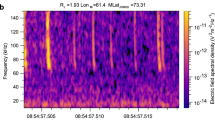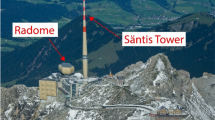Abstract
ONE of the difficulties about ball lightning is to explain the relatively large and stable diameter of the balls which would appear to be around 10–20 cm1, which is large relative to the dimensions of the main high-temperature and high current-carrying regions of these high-current discharges at atmospheric pressure. The purpose of this communication is to suggest that the lightning channel may, so to speak, ‘spring a leak’ at a ‘joint’, and allow an escape from it of the jet of hot gas which flows along it2, because of the decrease in current and current density in the return stroke from ground to cloud3.
This is a preview of subscription content, access via your institution
Access options
Subscribe to this journal
Receive 51 print issues and online access
$199.00 per year
only $3.90 per issue
Buy this article
- Purchase on Springer Link
- Instant access to full article PDF
Prices may be subject to local taxes which are calculated during checkout
Similar content being viewed by others
References
Singer, S., Nature, 198, 745 (1963).
Bruce, C. E. R., in Recent Advances in Atmospheric Electricity, edit. by Smith, L. G., 461 (Pergamon Press, 1959).
Bruce, C. E. R., Proc. Roy. Soc., A, 183, 228 (1944).
Bruce, C. E. R., and Golde, R. H., J. Inst. Elec. Eng., 88, 487 (1941).
Author information
Authors and Affiliations
Rights and permissions
About this article
Cite this article
BRUCE, C. Ball Lightning. Nature 202, 996–997 (1964). https://doi.org/10.1038/202996b0
Issue Date:
DOI: https://doi.org/10.1038/202996b0
This article is cited by
-
Eddy current model of ball lightning
Naturwissenschaften (1989)
-
Ball Lightning as an Optical Illusion
Nature (1971)
-
Ball Lightning
Nature (1969)
Comments
By submitting a comment you agree to abide by our Terms and Community Guidelines. If you find something abusive or that does not comply with our terms or guidelines please flag it as inappropriate.



